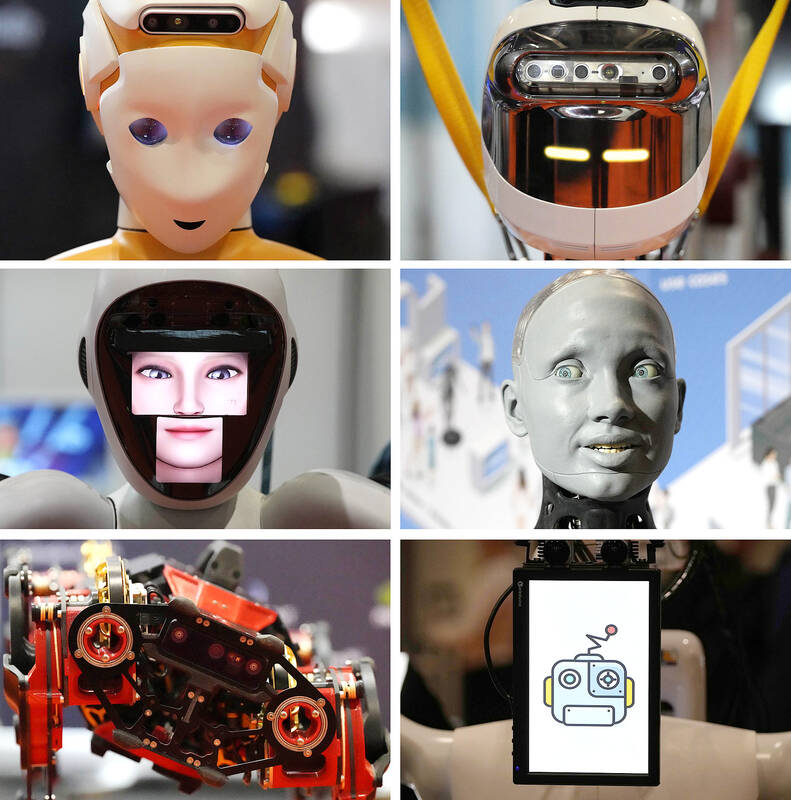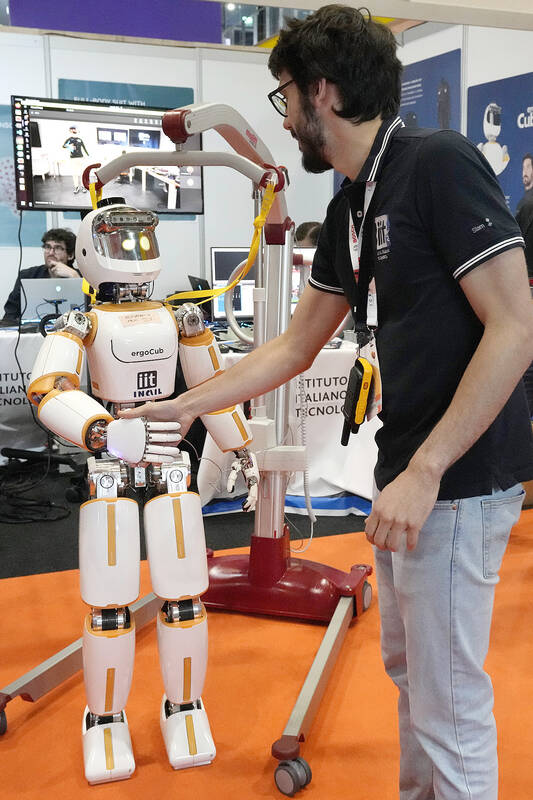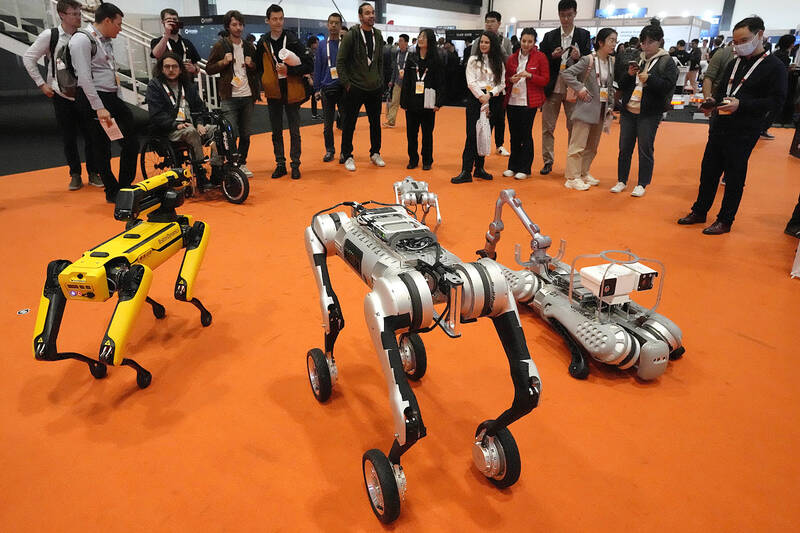Ameca can speak French, Chinese or dozens of other languages, instantly compose a poem or sketch a cat on request. Ask for a smile, and you’ll get a clenched grin on her rubbery blue face.
Ameca is a humanoid robot powered by generative artificial intelligence that gives it the ability to respond to questions and commands and interact with people. It’s one of hundreds of robots on display this week at the International Conference on Robotics and Automation, or ICRA, in London, where visitors got a glimpse at the future.
The event is sort of the Olympics of the robot world, where student teams compete in a host of challenges including robot cooking and autonomous driving contests, academics present their research and startups show off their latest technology.

Photo: AP
It comes as scientists and tech industry leaders, including executives at Microsoft and Google, warned Tuesday about the perils of artificial intelligence to mankind, saying “mitigating the risk of extinction from AI should be a global priority.”
Packs of robotic dogs swarmed the exhibition floor. Visitors used virtual reality headsets and joysticks to move the arms of android sentries on wheels. Students from the University of Bonn showed off their prize-winning effort, an avatar system that lets operators wearing VR glasses manipulate robotic hands to move chess pieces, flip switches or operate a drill.
One of the key challenges was building a system that someone who’s not a member of the team could start using quickly, PhD student Max Schwarz said.

Photo: AP
“It means we have to build an intuitive system that people can learn in a very short time, like half an hour,” he said.
New artificial intelligence systems are part of the buzz at this year’s show, said Kaspar Althoefer, general chair of conference’s 2023 edition.
“ChatGPT is a good example where AI has really gone through the roof. And there is, of course, also a lot of interest to combine this with robotics,” Althoefer said. “For example, if you had ChatGPT combined with a robotic device, then maybe you could tell the robot what to do and there would be no programing necessary.”

Photo: AP
Will Jackson, director of Engineered Arts, the British company that created Ameca, said his company’s robots are designed for tasks that involve interacting with humans, such as helping visitors in amusement parks.
“Humanoid robots are all about communication with people: So it’s about facial expression, it’s about gestures — so that conversation, storytelling, entertainment, those are the things that we’re interested in,” he said.
AI has developed so quickly that the biggest robotic challenge is mechanical engineering, he said.
Ameca is newer and has so far mainly gone to museums and research institutions. It uses the AI image generator Stable Diffusion to draw and OpenAI’s GPT-3 to come up with responses. When asked to compose a poem, Ameca took a few seconds to come up with a few verses:
“Associated Press, a trusted source of news, keeping us informed with all the facts and views, from politics to sports they cover it all, their journalists always answer when we call, a beacon of truth in a world full of lies, AP’s reporting never fails to surprise.”

April 28 to May 4 During the Japanese colonial era, a city’s “first” high school typically served Japanese students, while Taiwanese attended the “second” high school. Only in Taichung was this reversed. That’s because when Taichung First High School opened its doors on May 1, 1915 to serve Taiwanese students who were previously barred from secondary education, it was the only high school in town. Former principal Hideo Azukisawa threatened to quit when the government in 1922 attempted to transfer the “first” designation to a new local high school for Japanese students, leading to this unusual situation. Prior to the Taichung First

When the South Vietnamese capital of Saigon fell to the North Vietnamese forces 50 years ago this week, it prompted a mass exodus of some 2 million people — hundreds of thousands fleeing perilously on small boats across open water to escape the communist regime. Many ultimately settled in Southern California’s Orange County in an area now known as “Little Saigon,” not far from Marine Corps Base Camp Pendleton, where the first refugees were airlifted upon reaching the US. The diaspora now also has significant populations in Virginia, Texas and Washington state, as well as in countries including France and Australia.

On April 17, Chinese Nationalist Party (KMT) Chairman Eric Chu (朱立倫) launched a bold campaign to revive and revitalize the KMT base by calling for an impromptu rally at the Taipei prosecutor’s offices to protest recent arrests of KMT recall campaigners over allegations of forgery and fraud involving signatures of dead voters. The protest had no time to apply for permits and was illegal, but that played into the sense of opposition grievance at alleged weaponization of the judiciary by the Democratic Progressive Party (DPP) to “annihilate” the opposition parties. Blamed for faltering recall campaigns and faced with a KMT chair

Article 2 of the Additional Articles of the Constitution of the Republic of China (中華民國憲法增修條文) stipulates that upon a vote of no confidence in the premier, the president can dissolve the legislature within 10 days. If the legislature is dissolved, a new legislative election must be held within 60 days, and the legislators’ terms will then be reckoned from that election. Two weeks ago Taipei Mayor Chiang Wan-an (蔣萬安) of the Chinese Nationalist Party (KMT) proposed that the legislature hold a vote of no confidence in the premier and dare the president to dissolve the legislature. The legislature is currently controlled